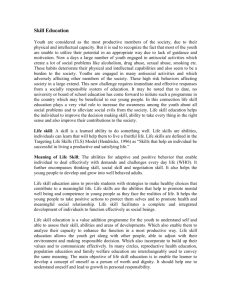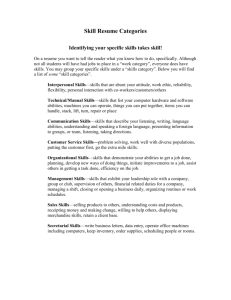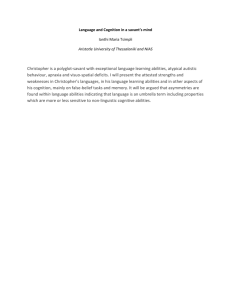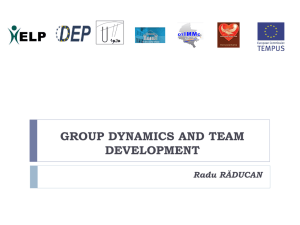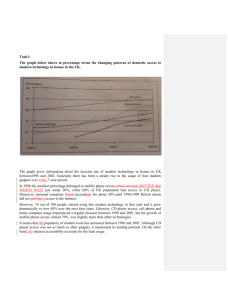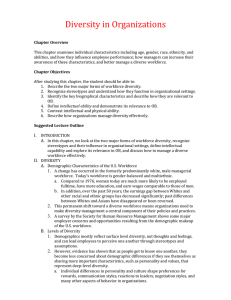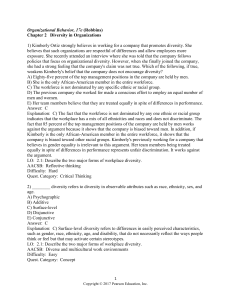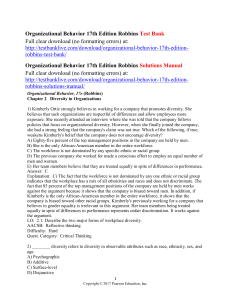BUS-201-202: TUTORIAL 2 Class Exercise Have the students divide
advertisement
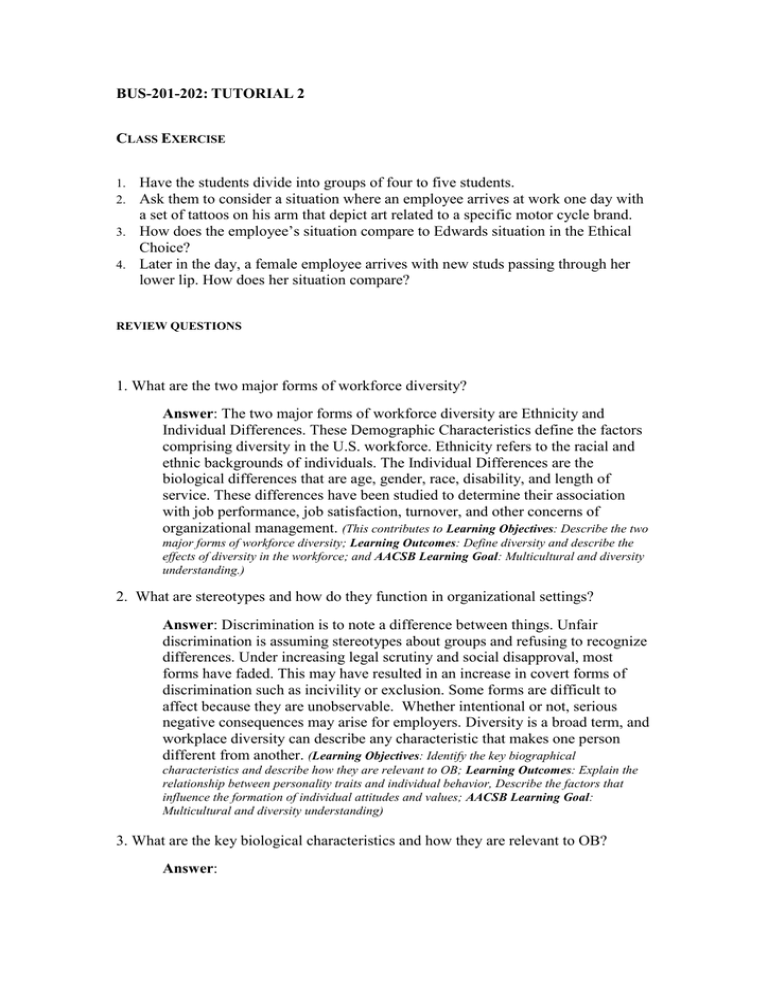
BUS-201-202: TUTORIAL 2 CLASS EXERCISE Have the students divide into groups of four to five students. Ask them to consider a situation where an employee arrives at work one day with a set of tattoos on his arm that depict art related to a specific motor cycle brand. 3. How does the employee’s situation compare to Edwards situation in the Ethical Choice? 4. Later in the day, a female employee arrives with new studs passing through her lower lip. How does her situation compare? 1. 2. REVIEW QUESTIONS 1. What are the two major forms of workforce diversity? Answer: The two major forms of workforce diversity are Ethnicity and Individual Differences. These Demographic Characteristics define the factors comprising diversity in the U.S. workforce. Ethnicity refers to the racial and ethnic backgrounds of individuals. The Individual Differences are the biological differences that are age, gender, race, disability, and length of service. These differences have been studied to determine their association with job performance, job satisfaction, turnover, and other concerns of organizational management. (This contributes to Learning Objectives: Describe the two major forms of workforce diversity; Learning Outcomes: Define diversity and describe the effects of diversity in the workforce; and AACSB Learning Goal: Multicultural and diversity understanding.) 2. What are stereotypes and how do they function in organizational settings? Answer: Discrimination is to note a difference between things. Unfair discrimination is assuming stereotypes about groups and refusing to recognize differences. Under increasing legal scrutiny and social disapproval, most forms have faded. This may have resulted in an increase in covert forms of discrimination such as incivility or exclusion. Some forms are difficult to affect because they are unobservable. Whether intentional or not, serious negative consequences may arise for employers. Diversity is a broad term, and workplace diversity can describe any characteristic that makes one person different from another. (Learning Objectives: Identify the key biographical characteristics and describe how they are relevant to OB; Learning Outcomes: Explain the relationship between personality traits and individual behavior, Describe the factors that influence the formation of individual attitudes and values; AACSB Learning Goal: Multicultural and diversity understanding) 3. What are the key biological characteristics and how they are relevant to OB? Answer: 1. 2. 3. 4. 5. 6. 7. Age - Older workers bring experience, judgment, a strong work ethic, and commitment to quality. Gender - Few differences between men and women that affect job performance. Race - (the biological heritage used to identify oneself) Contentious issue: differences exist, but could be more culture-based. Tenure - People with job tenure (seniority at a job) are more productive, absent less frequently, have lower turnover, and are more satisfied. Religion - Islam is especially problematic in the workplace in this post9/11 world. Sexual Orientation - Federal law does not protect against discrimination (but state or local laws may). Domestic partner benefits are important considerations. Gender Identity - Relatively new issue – transgendered employees. These characteristics are important to OB since corporations are always searching for variables that can impact employee productivity, turnover, deviance, citizenship and satisfaction. Data that is easily defined and available in an employee personnel file can contribute to success in an organization. (Learning Objectives: Identify the key biographical characteristics and describe how they are relevant to OB; Learning Outcomes: Explain the relationship between personality traits and individual behavior, Describe the factors that influence the formation of individual attitudes and values; AACSB Learning Goal: Multicultural and diversity understanding) 4. What is intellectual ability and demonstrate its relevance to OB? 1. Answer: Intellectual abilities are the abilities needed to perform mental abilities-thinking, reasoning, and problem solving. Understanding the concept is essential to managers as they plan, organize, direct, and control a firm’s operations. Since different jobs require different application of abilities, the challenge of job design, recruiting and selecting workers, and evaluating performance a based in applying the needed intellectual abilities to ensure fairness and appropriateness of management activities. (Learning Objectives: Define intellectual ability and demonstrate its relevance to OB; Learning Outcomes: Explain the relationship between personality traits and individual behavior, Describe the factors that influence the formation of individual attitudes and values; AACSB Learning Goal: Multicultural and diversity understanding) 5. How can you contrast intellectual from physical ability? Answer: The two types of abilities are intellectual abilities and physical abilities. Intellectual abilities lead to the metal abilities needed to perform jobs in the changing operational environments of today’s business. Physical abilities have been a factor of job design and performance since Fredrick Taylor’s Scientific Management. Studies have suggested nine different Physical Abilities performed in work. They are mutually exclusive. Therefore, they are important considerations in the management functions. (Learning Objectives: Contrast intellectual from physical ability; Learning Outcomes: Explain the relationship between personality traits and individual behavior, Describe the factors that influence the formation of individual attitudes and values; AACSB Learning Goal: Multicultural and diversity understanding) 6. How do organizations manage diversity effectively? Answer: Effective Diversity Management capitalizes on diversity for organizational success. This includes recruiting and selection as well as training and development of employees to take advantage of diverse workforces. Effective programs have three components: 1. They teach managers about the legal framework for equal employment opportunity and encourage fair treatment of all people. 2. They teach managers how a diverse workforce will be better able to serve a diverse market of customers and clients. 3. They foster personal development practices that bring out the skills and abilities of all workers. (Learning Objectives: Describe how organizations manage diversity effectively; Learning Outcomes: Explain the relationship between personality traits and individual behavior, Describe the factors that influence the formation of individual attitudes and values; AACSB Learning Goal: Multicultural and diversity understanding)


